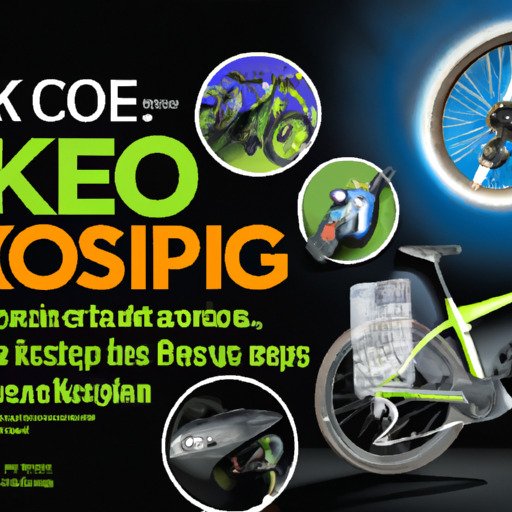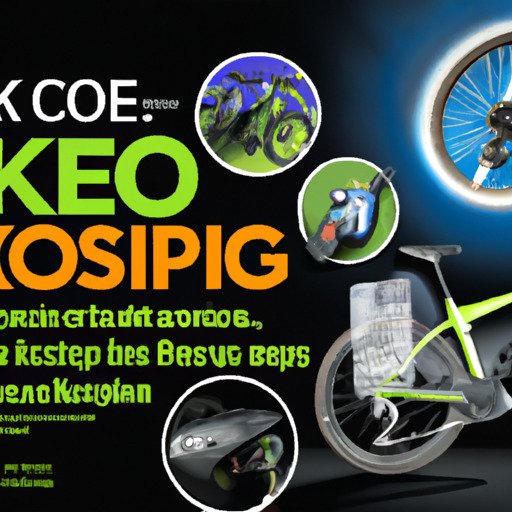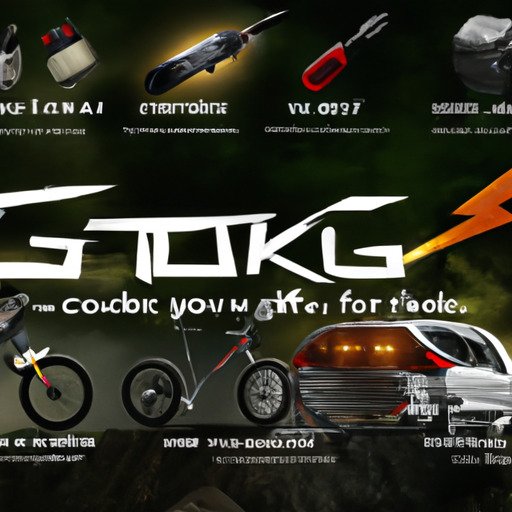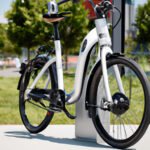
Curious about what’s new in the world of e-bike technology? Well, you’re in luck! In this article, we’ll dive into some of the latest advancements that have been made in this exciting field. From improved battery technology to smarter bike controls, there are plenty of exciting developments to explore. So, if you’re a fan of e-bikes or simply interested in staying up to date with the latest trends, keep reading!
So, what can you expect to learn in this article? We’ll start by looking at advancements in e-bike batteries, including longer battery life and faster charging times. Then, we’ll explore the world of smart features, such as integrated GPS and mobile app connectivity, which allow riders to customize their e-bike experience. Additionally, we’ll discuss advancements in motor technology and how they can provide a smoother and more efficient ride. So, get ready to be amazed by the latest innovations in e-bike technology – this is an article you won’t want to miss! With the popularity of e-bikes soaring in recent years, manufacturers have been continuously working on improving the technology to enhance the overall riding experience. From battery technology to safety enhancements, there have been numerous advancements that have made electric bikes more efficient, powerful, and safe. In this article, we will explore the latest advancements in e-bike technology and how they have revolutionized the way we ride.

1. Battery Technology
Lithium-ion Batteries
One of the most important advancements in e-bike technology is the development of lithium-ion batteries. These batteries are lightweight, durable, and have a high energy density, allowing them to store more power and provide a longer range. Lithium-ion batteries also have a high power output, enabling riders to experience faster acceleration and better performance.
Longer Battery Life
Gone are the days when e-bike batteries would drain quickly, leaving riders stranded mid-ride. Thanks to advancements in battery technology, e-bikes now come with longer battery life, allowing riders to cover more distance on a single charge. This extended battery life has made e-bikes a viable mode of transportation for longer commutes and outdoor adventures.
Fast Charging
Another major advancement in e-bike battery technology is the introduction of fast charging capabilities. With fast charging, riders can quickly recharge their e-bikes and get back on the road in no time. This is especially useful for riders who rely on their e-bikes for daily commuting or those who want to make the most out of their riding time without the inconvenience of waiting for hours to charge their batteries.
2. Motor Systems
Mid-drive Motors
Mid-drive motors have become increasingly popular in e-bike technology due to their efficient power transfer and improved handling. Unlike hub motors, which are located in the front or rear wheel, mid-drive motors are positioned at the bike’s crankshaft, directly powering the pedals. This allows for better weight distribution and a more natural riding experience.
Hub Motors
Although mid-drive motors have gained popularity, hub motors still have their own advantages. Hub motors are integrated into the wheel hub, providing a simpler and more compact design. They require less maintenance and are easier to install. Additionally, some riders prefer the direct drive feeling and smooth acceleration of hub motors.
Integrated Motor and Battery Systems
In recent years, manufacturers have been working on integrating the motor and battery systems seamlessly into the e-bike frame. This not only enhances the aesthetics of the bike but also improves overall performance and weight distribution. Integrated systems also allow for better control and customization options, as riders can fine-tune the motor and battery settings to suit their preferences.
3. Lightweight Materials
Carbon Fiber Frames
In the pursuit of lightweight yet strong e-bike frames, carbon fiber has become a popular choice among manufacturers. Carbon fiber frames are known for their high strength-to-weight ratio, making them lighter and more rigid than traditional materials. This allows for better power transfer, improved handling, and increased overall performance.
Aluminum Alloys
Another lightweight material that has found its way into e-bike frame construction is aluminum alloy. Aluminum frames are relatively affordable, durable, and lightweight. They offer a good balance between weight and strength, making them suitable for riders who want a reliable and efficient e-bike without breaking the bank.
Titanium Components
For those looking for the ultimate lightweight e-bike, titanium components are the way to go. While titanium frames are not as common due to their high cost, titanium components such as handlebars, stems, and seat posts are becoming increasingly popular. Titanium is known for its outstanding strength-to-weight ratio, corrosion resistance, and durability, making it an ideal choice for riders who prioritize lightweight performance.
4. Smart Features
Bluetooth Connectivity
With the advent of smart technology, e-bikes now come equipped with Bluetooth connectivity. This allows riders to connect their e-bikes to their smartphones and access a range of features, including navigation, fitness tracking, and performance monitoring. Bluetooth connectivity also enables riders to customize their e-bike settings, update firmware, and connect to other smart devices.
GPS Navigation
Gone are the days of getting lost while riding your e-bike. Many e-bikes now come with built-in GPS navigation systems, allowing riders to easily navigate through unfamiliar terrain. These systems provide real-time directions, turn-by-turn guidance, and even suggestions for cycling-friendly routes. With GPS navigation, riders can confidently explore new areas without the fear of losing their way.
Integrated Smartphone Apps
In addition to Bluetooth connectivity and GPS navigation, e-bikes are also equipped with integrated smartphone apps that provide a range of features and functionalities. These apps allow riders to monitor battery charge, adjust power settings, track fitness metrics, and even connect with a community of fellow riders. The integration of smartphone apps has not only made e-bikes more convenient but has also enhanced the overall riding experience.

5. Regenerative Braking
Energy Recovery
Regenerative braking is a technology that allows e-bikes to recover and store the energy generated during braking. When the brakes are applied, the motor switches to generator mode, converting the kinetic energy into electrical energy, which is then stored in the battery for future use. This energy recovery system not only increases the overall range of the e-bike but also reduces the wear and tear on the brake pads.
Increased Range
With the implementation of regenerative braking, e-bikes now have an increased range, as the energy recovered during braking is used to power the bike. This means that riders can go further on a single charge and rely less on external charging sources. The combination of regenerative braking and advancements in battery technology has significantly enhanced the overall range and efficiency of e-bikes.
Improved Efficiency
By utilizing regenerative braking, e-bikes have become more energy-efficient. The recovered energy is used to supplement the power provided by the battery, reducing the strain on the battery and extending its lifespan. This improved efficiency not only benefits the environment by reducing the carbon footprint but also allows riders to ride for longer periods without worrying about running out of power.
6. Advanced Suspension Systems
Full Suspension
To enhance rider comfort and improve overall handling, e-bikes are now equipped with advanced suspension systems. Full suspension e-bikes feature both front and rear suspension, absorbing bumps and vibrations from the terrain. This not only provides a smoother ride but also increases traction, control, and stability, especially on rough and uneven surfaces.
Electronic Damping
Electronic damping is a technology that allows riders to adjust the suspension settings on-the-fly, depending on the terrain and riding conditions. With electronic damping, riders can select different modes such as firm, medium, or soft suspension, to optimize performance and comfort. This feature is particularly useful for riders who frequently switch between different types of terrain, as it provides versatility and adaptability.
Adjustable Compression and Rebound
In addition to electronic damping, e-bikes also come with adjustable compression and rebound settings, allowing riders to fine-tune their suspension to match their riding style and preference. These adjustments can significantly impact the bike’s performance, especially in terms of responsiveness, stability, and control. By having the ability to customize the compression and rebound settings, riders can optimize their e-bike’s suspension for maximum comfort and performance.
7. Safety Enhancements
Anti-lock Braking System (ABS)
Safety is a top priority for e-bike manufacturers, and one of the latest advancements in this area is the implementation of anti-lock braking systems (ABS). ABS prevents the wheels from locking up during sudden or hard braking, reducing the risk of skidding and improving overall control. This technology ensures that riders can confidently and safely come to a stop, even in emergency situations or on slippery surfaces.
Automatic Emergency Braking
Another safety enhancement in e-bike technology is automatic emergency braking. This feature uses sensors and algorithms to detect potential collisions and automatically applies the brakes to prevent or minimize the impact. Automatic emergency braking is particularly beneficial in urban environments or crowded areas where unexpected obstacles or pedestrians may appear suddenly.
Rearview Cameras
To improve rider awareness and safety, e-bikes now come equipped with rearview cameras. These cameras provide a live video feed to a display mounted on the handlebars, allowing riders to see what is behind them without having to turn their heads. Rearview cameras enable riders to make safer lane changes, merge into traffic, and react to potential hazards.
8. Customization Options
Different Riding Modes
One of the latest trends in e-bike technology is the availability of different riding modes. These modes allow riders to customize their e-bike’s performance to suit their riding style and preference. Common riding modes include eco mode for maximum battery efficiency, normal mode for a balanced performance, and sport mode for maximum power and speed. Different riding modes give riders the flexibility to optimize their e-bike’s performance for various situations and terrains.
Adjustable Power Settings
Adjustable power settings are another customization option that e-bike riders can take advantage of. With adjustable power settings, riders can choose how much assistance the motor provides, allowing them to conserve battery power on easier terrains or increase the assistance for challenging uphill climbs. Adjustable power settings give riders greater control over their riding experience and allow them to match the e-bike’s power output to their fitness level and desired level of exertion.
Modular Design
Modular design has become increasingly popular in e-bike technology as it allows riders to easily customize and upgrade their e-bikes. With a modular design, riders can swap out components such as the battery, motor, or even the frame, to better suit their needs and preferences. This flexibility ensures that riders can enjoy the latest advancements in technology without having to invest in a completely new e-bike.
9. Enhanced Range
Greater Battery Capacity
One of the main factors limiting the range of e-bikes is the capacity of the battery. To address this, manufacturers have been increasing the battery capacity, allowing riders to cover more distance on a single charge. Greater battery capacity means longer rides, increased versatility, and reduced reliance on external charging sources.
Efficient Motor Systems
In addition to greater battery capacity, advancements in motor systems have also contributed to enhanced range. Motors are becoming more efficient, allowing them to convert electrical energy into mechanical power with greater efficiency. This means that riders can travel further on the same amount of energy, maximizing the e-bike’s range and making it more suitable for long-distance rides.
Improved Aerodynamics
Another factor that affects the range of an e-bike is aerodynamics. Manufacturers are now focusing on designing e-bikes with improved aerodynamic features, such as sleek frames and streamlined components. These aerodynamic enhancements reduce air resistance, allowing riders to achieve higher speeds with less effort. Improved aerodynamics not only increases the range but also enhances the overall efficiency and performance of the e-bike.
Conclusion
In conclusion, e-bike technology has come a long way in recent years, with advancements in battery technology, motor systems, lightweight materials, smart features, regenerative braking, suspension systems, safety enhancements, customization options, and range improvements. These advancements have made e-bikes more efficient, powerful, and safe, offering riders a more enjoyable and convenient mode of transportation. Whether you’re a commuter looking for an eco-friendly option, an adventure seeker wanting to explore new terrains, or a fitness enthusiast seeking an alternative to traditional biking, the latest advancements in e-bike technology have something to offer for everyone. So, hop on an e-bike and experience the thrill of the future of cycling!




















